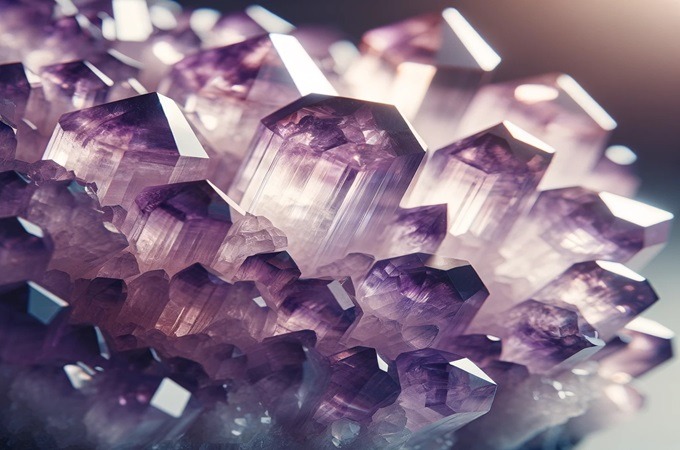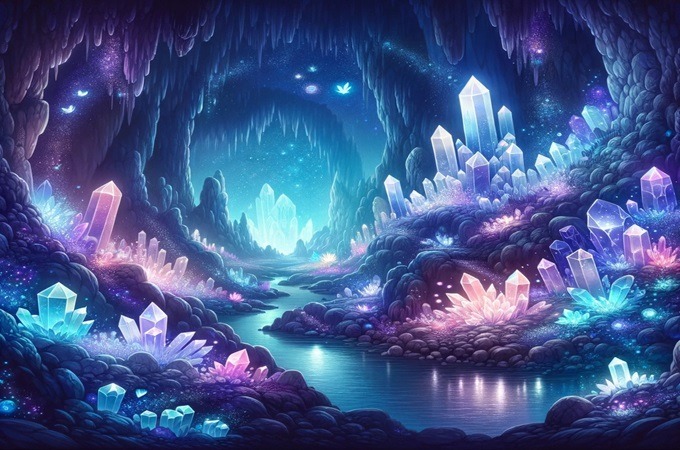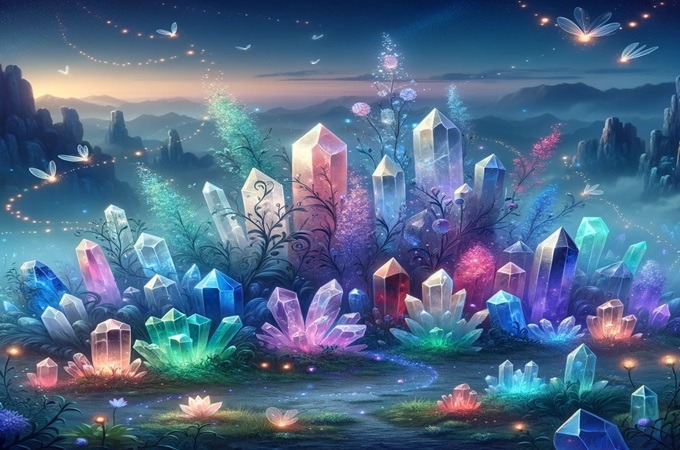Crystals
Crystals, the earth’s hidden treasures, have been captivating humanity with their mesmerizing beauty and enigmatic presence for millennia. From the depths of the earth to the apex of royal crowns, these natural wonders have carved a niche in the heart of human civilization. In this illuminating journey, we’ll unravel the beauty and mystery of crystals, delving into their crystalline cores to reveal secrets as old as time.
Unearthing the Sparkling Secrets
Crystals are not mere stones; they are stories solidified, whispering tales of ancient times and faraway lands. They are nature’s own art, fashioned under the watchful eyes of geological forces. What makes them so alluring? Is it their perfect symmetry, their rainbow of colors, or the way they play with light, turning a sunbeam into a dance of dazzling sparkles?
A Glimpse into the Past
Beyond their beauty, crystals hold a cultural significance that has stood the test of time. They’ve been revered as divine conduits, healing aids, and even tools of power. Their historical use spans across continents and cultures, from the mystical rites of the Mayans to the healing chambers of Chinese emperors.
The Science of Sparkle
Scientifically, crystals are a marvel—a symphony of atoms arranged in magical order, resulting in forms that are as precise as they are beautiful. How do these structures form? What secrets lie in their geometric embrace? And how have these subterranean spectacles grown to become a cornerstone of modern technology?
From the Earth to Us
As we journey through the types of crystals, from the serene amethyst to the vibrant citrine, we’ll explore not just their aesthetic glory, but also their perceived properties. We’ll dive into crystallography, the piezoelectric effects of quartz, and the role of crystals in today’s technological advancements.
This introduction is just the beginning. Prepare to embark on an odyssey of discovery, where each facet of a crystal reflects a chapter of history, a piece of science, and a fragment of the human spirit. Let’s uncover the beauty and mystery of crystals together.

What Are Crystals? Understanding the Basics
Crystals are the masterpieces of the natural world, a testament to the artistry of Mother Earth. At their essence, they’re a symphony of atoms and molecules locked in a harmonious, structured pattern that repeats itself in three dimensions. But there’s more to these glinting gems than meets the eye. Let’s dive deeper into their crystalline depths.
Defining Crystals Scientifically
A crystal is not just any solid. By scientific standards, it’s a solid material whose constituents, such as atoms, molecules, or ions, are arranged in a highly ordered structure. This structure forms a lattice that extends in all directions, giving rise to the crystal’s characteristic shapes and facets. This orderly pattern is what gives crystals their radiant sparkle and is a key identifier in distinguishing them from other natural formations.
How Crystals Form in Nature
The birth of a crystal, a process known as crystallization, is a natural marvel. It can occur from cooling magma, evaporating water, or more rarely, from gases. The conditions have to be just right, with the perfect balance of temperature and pressure, leading to an awe-inspiring array of shapes and sizes. Some crystals form over millennia, growing slowly in the hidden nooks of our planet, while others might crystallize rapidly during sudden cooling events.
Different Crystal Systems and Structures
Did you know that crystals are categorized into different systems based on their atomic arrangement? Here’s a snapshot:
- Cubic (or Isometric) System: Think of the perfection of a cube, like the salt on your table or the pyrite in a museum.
- Tetragonal System: Picture a stretched or squished cube, a bit like zircon crystals.
- Orthorhombic System: Envision rectangles seated on top of each other, as seen in topaz.
- Hexagonal System: A six-sided wonder, like the quartz in a stunning geode.
- Trigonal System: A subset of the hexagonal, but with a three-fold axis, much like ruby.
- Monoclinic System: Crystals with a slant, like the lovely gypsum.
- Triclinic System: The least symmetric, but still captivating crystals, such as turquoise.
Each crystal structure not only determines the external shape but also influences the crystal’s properties and, according to some, its energetic qualities.
The world of crystals is vast and varied, with each type holding its own unique blueprint. As we move forward, we’ll explore the fascinating families of crystals and their characteristics, diving into the quartz and beryl families, and even touching on organic crystals like amber and pearl. Get ready to be astounded by the complexity and diversity of these natural wonders.
Types of Crystals and Their Characteristics
Crystals come in an array of types, each with their unique charm and purported properties. Let’s explore some of the most renowned crystal families and their members, unveiling the tapestry of color, form, and legend that they bring to the world of gemstones.
Quartz Family
Amethyst: The Purple Powerhouse
- Color: Ranges from light lavender to deep violet
- Properties: Believed to bring clarity of mind and calmness; associated with the crown chakra
- Uses: Popular in jewelry, meditation, and as a decorative piece
Citrine: Sunshine Solidified
- Color: Warm yellow to rich, golden brown
- Properties: Thought to inspire joy and attract prosperity; linked to the solar plexus chakra
- Uses: Sought after for jewelry and as a ‘merchant’s stone’ to promote success
Beryl Family
Emerald: The Green Gem of Goddesses
- Color: Deep green, often with inclusions that add character
- Properties: Symbolizes rebirth and love; said to enhance intuition
- Uses: A prized stone for high-end jewelry, often associated with royalty
Aquamarine: Calm Seas Captured
- Color: Light blue to blue-green, evoking tranquil waters
- Properties: Alleged to soothe and cleanse, much like the ocean; tied to the throat chakra
- Uses: Favored in jewelry that reflects the sea’s hues, also used in meditation for its calming effects
Organic Crystals
Amber: Time-Trapped Beauty
- Origin: Fossilized tree resin, not a mineral crystal, but often grouped with them due to its crystalline nature
- Properties: Associated with healing and longevity; purported to absorb negativity
- Uses: Crafted into jewelry, amulets, and decorative objects; also studied for its prehistoric inclusions
Pearl: Ocean’s Gentle Gift
- Origin: Formed within the shell of a mollusk, another organic member of the crystal family
- Properties: Symbolizes purity and wisdom; believed to offer protection
- Uses: A staple in jewelry, from classic strands of pearls to modern designs
These crystals and gemstones have been admired not only for their beauty but also for the meanings ascribed to them. Whether these properties hold true or are born from the human penchant for storytelling, they add an extra layer of intrigue to each crystal.

Crystals in History and Mythology
Crystals have not only graced the crowns of monarchs and the necks of the elite; they have been interwoven into the very fabric of ancient history and mythology. Let’s unearth the roles these gleaming gifts from the earth have played across different civilizations and the mythical narratives that have immortalized them.
Ancient Beliefs and Crystal Usage
Across the globe, ancient cultures harnessed the allure of crystals, attributing to them powers beyond the physical. Here’s how various civilizations integrated crystals into their way of life:
- Egyptians: Used lapis lazuli for protection in the afterlife, and clear quartz to craft potent talismans.
- Greeks: Revered crystals like hematite, naming it after the word for blood because of its red coloration when oxidized.
- Chinese: Incorporated jade into their medicinal practices and as a symbol of prosperity and purity.
| Culture | Crystal | Use |
|---|---|---|
| Egyptian | Lapis Lazuli | Protection, Jewelry |
| Greek | Hematite | Healing, Amulets |
| Chinese | Jade | Medicine, Ornamentation |
Mythological Stories and Legendary Crystals
Mythology is replete with tales of crystals with divine or otherworldly origins. These stories often imbue crystals with mystical qualities:
- Atlantean Lore: Legends speak of a crystal so powerful within the lost city of Atlantis that it could harness energy from the stars.
- Nordic Sagas: The Vikings, per tales, had the “sunstone,” a crystal that helped them navigate the seas on overcast days.
Crystals in Ancient Medicine and Rituals
Ancient civilizations also saw crystals as essential components in healing practices and ceremonial rites:
- Mayans: Employed jade in masks and tools, believing it could cure ailments and ensure a bountiful harvest.
- Native Americans: Used turquoise for its healing properties and as a protector against evil spirits.
The role of crystals throughout history is not just a testament to their enduring appeal but also to humanity’s longstanding quest to understand and harness the powers of the natural world. These stories and practices pave the way to modern interpretations of crystals’ significance, bridging the gap between ancient wisdom and contemporary curiosity.
The Science Behind Crystals
While the myths and legends of crystals enchant the mind, the science behind these natural wonders is equally mesmerizing. Crystallography, the study of crystal structures and their properties, reveals the hidden world within these stones, leading to technological advancements that shape our modern lives.
Crystallography: The Study of Crystal Structures
Crystallography is a branch of science that examines the arrangement of atoms in crystalline solids. By understanding the molecular blueprint of a crystal, scientists can predict and explain its physical properties and behaviors. This field has evolved with the advent of X-ray diffraction, a technique that allows for a glimpse into the atomic arrangement of crystals, leading to breakthroughs in multiple scientific fields.
Piezoelectricity in Crystals and Modern Applications
Some crystals exhibit a fascinating property known as piezoelectricity. When mechanical stress is applied to these crystals, they generate an electrical charge. This remarkable trait has practical applications:
- Quartz Watches: The consistent vibration of quartz under an electric field keeps time with astonishing precision.
- Medical Equipment: Piezoelectric crystals are pivotal in ultrasound devices, translating electric signals into sound waves and back.
The Role of Crystals in Technological Advancements
The influence of crystals on technology is undeniable. Silicon crystals are the heart of the computer industry, forming the base of semiconductors. Liquid crystal displays (LCDs) have revolutionized the way we view content, from digital watches to flat-screen TVs. Even our smartphones rely on crystals for their touchscreens and internal components.
Read More: Miscellaneous
The scientific journey into the heart of crystals reveals a world where form and function intertwine, where natural beauty meets technological utility. As we have harnessed their potential, crystals have proven to be more than just decorative – they are fundamental to the advancement of our technological landscape.

The Timeless Allure of Crystals
From the molten cores of the earth to the pinnacle of high technology, crystals have fascinated and served humanity across the ages. They have been adorned as jewels, wielded as talismans, and utilized in technological marvels—each crystal resonating with a story as old as time.
Summarizing the Enduring Fascination with Crystals
The journey of crystals through human history is as layered as the stones themselves. Whether believed to heal, protect, or empower, crystals have held a mirror to our deepest beliefs and aspirations. Their allure lies not only in their physical beauty but in the profound ways they have become embedded in our cultural and technological narratives.
The Multifaceted Roles of Crystals in Society
Today, crystals continue to captivate with their multifaceted roles—from spiritual enhancers in healing practices to critical components in electronic devices. The crystal phenomenon is a unique intersection of nature, science, art, and spirituality, reflecting the diverse ways we appreciate and utilize the earth’s resources.
Encouraging Responsible and Informed Engagement with Crystals
It’s crucial to approach our fascination with crystals with mindfulness and responsibility as we continue to be enamored of their mystique. Sustainable sourcing, environmental consciousness, and ethical practices should guide our interactions with the crystal world, ensuring that our enchantment does not come at the cost of the planet.
Crystals, in their silent beauty, remind us of the incredible wonders our earth holds. As we close this chapter, let’s carry forward the message that while we enjoy the treasures of the earth, we also uphold our duty to protect and preserve them for generations to come.
And now, we turn to you, the reader. Whether you are a seasoned crystal collector, a practitioner of alternative medicine, or simply someone intrigued by the sparkle of these natural wonders, we invite you to share your experiences. How have crystals touched your life? Join the conversation and continue exploring the fascinating world of crystals.






